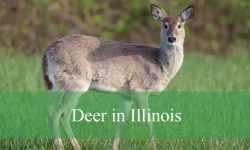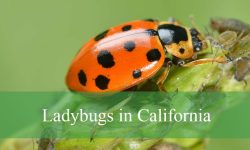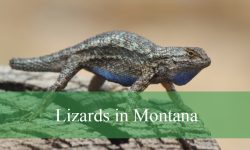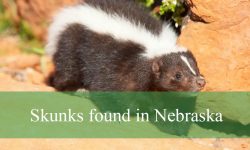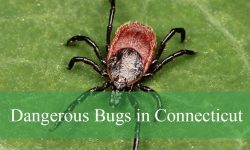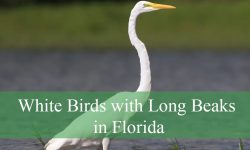Indiana boasts a rich variety of wild birds that attract birdwatchers and nature enthusiasts throughout the year. From vibrant songbirds to impressive birds of prey, the state provides diverse habitats ideal for observing fascinating feathered species. Exploring wild birds in Indiana promises an exciting and rewarding experience for all levels of bird lovers.
This guide presents the 25 best wild birds in Indiana that are commonly spotted across the state. Each bird includes clear pictures and detailed identification tips to help you recognize them in their natural environment. You will also discover information about their unique characteristics, behaviors, habitats, and songs to enhance your birdwatching adventures.
By exploring Indiana’s forests, wetlands, and suburban areas, birdwatchers can encounter a wide range of wild birds in Indiana. This list aims to deepen your appreciation for the state’s avian diversity and inspire you to connect with nature through bird observation.
Common Wild Birds Found in Indiana
Song Sparrow
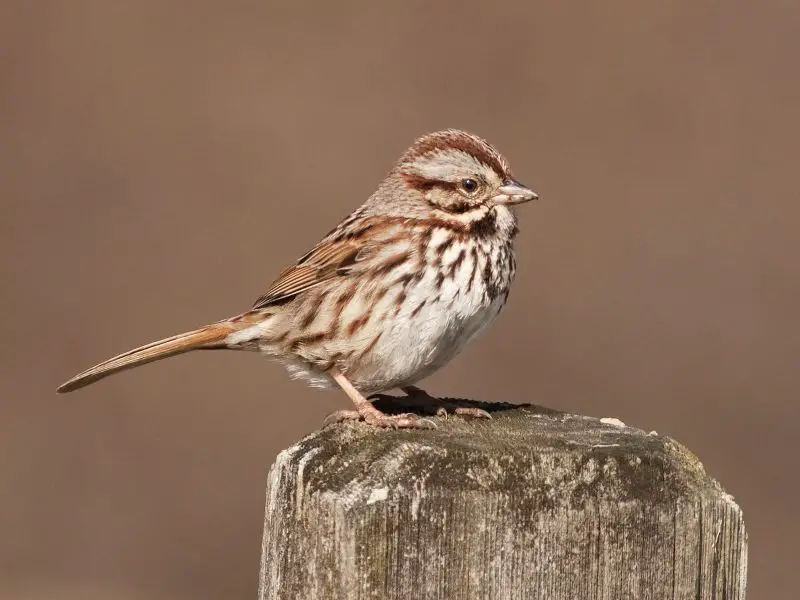
The Song Sparrow is a medium-sized sparrow recognized for its streaked brown plumage and distinctive central breast spot. Measuring about 5-7 inches long with a wingspan around 7-9 inches, these birds have a rounded head and a fairly long tail. Their coloration helps them blend into brushy and grassy environments where they often reside.
Their name comes from their rich, melodious song, which varies regionally but typically consists of a series of trills and clear notes that are often repeated. This song is commonly heard in Indiana’s wetlands, marshes, and woodland edges during the breeding season. Song Sparrows use their vocalizations to defend territory and attract mates.
The diet of Song Sparrows includes seeds, insects, and small invertebrates. They forage primarily on or near the ground in dense vegetation. Song Sparrows prefer habitats such as thickets, marshes, and open woodlands, and are widely distributed across Indiana throughout the year.
Northern Cardinal
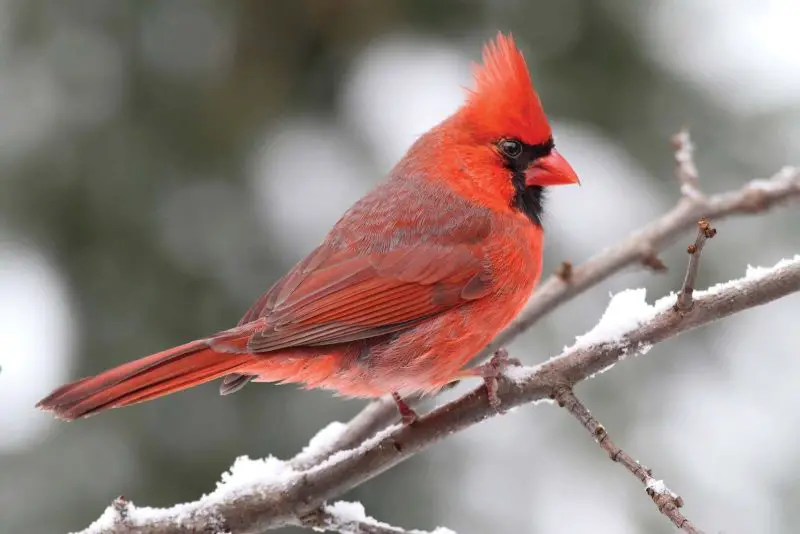
The Northern Cardinal is one of the most recognizable wild birds in Indiana, famous for its vibrant red plumage in males and warm brown tones with red accents in females. Adult males display a striking crest on their heads and a distinctive black mask around their bright orange-red beaks. Cardinals are medium-sized birds, measuring about 8-9 inches in length with a wingspan around 10-12 inches.
Identifying a Northern Cardinal is relatively easy due to its bold coloration and clear silhouette, especially the crest on top of its head. Their song consists of a series of clear, whistling notes that sound like “cheer, cheer, cheer” or “birdie, birdie, birdie,” which can be heard throughout Indiana’s forests, backyards, and parks. The cardinal’s call is often used as a symbol of cheerfulness and vitality.
Northern Cardinals primarily eat seeds, fruits, and insects. They are commonly found in wooded areas, shrublands, and suburban gardens across Indiana, especially during the breeding season. Their adaptability to various habitats makes them a year-round resident in the state, thriving in both rural and urban environments.
American Robin
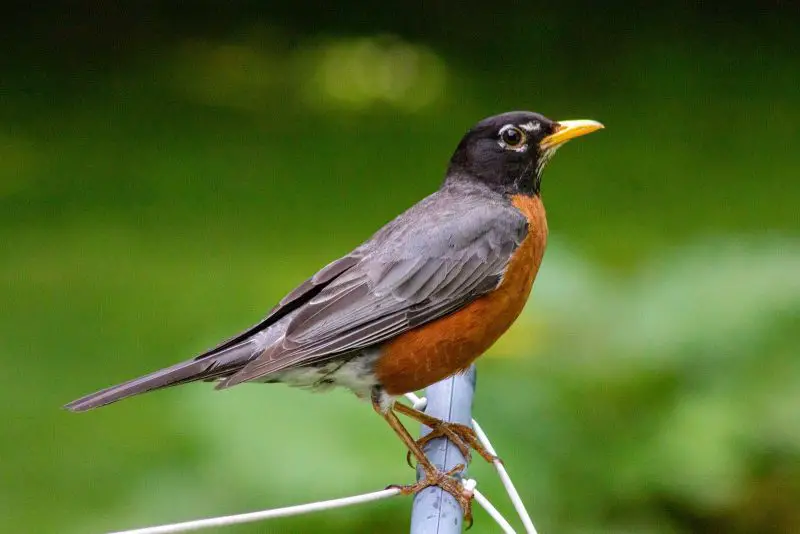
The American Robin is a familiar and widespread bird in Indiana, easily spotted by its round body, long legs, and distinct orange-red breast contrasted with a gray-brown back. Adult robins measure approximately 9-11 inches long with a wingspan of about 12-16 inches. They have a white eye ring that adds to their recognizable face.
Robins are known for their melodious and varied songs, a series of clear whistles that brighten early spring mornings across Indiana. Their calls include a sharp “tut-tut” sound often heard during flight or when alarmed. They are active foragers, often seen hopping on lawns looking for worms and insects.
American Robins primarily feed on earthworms, insects, and berries, shifting their diet seasonally. They favor open woodlands, parks, and suburban lawns in Indiana, making them one of the first signs of spring. Their widespread presence and adaptability have made them a beloved bird among Indiana residents.
Eastern Bluebird
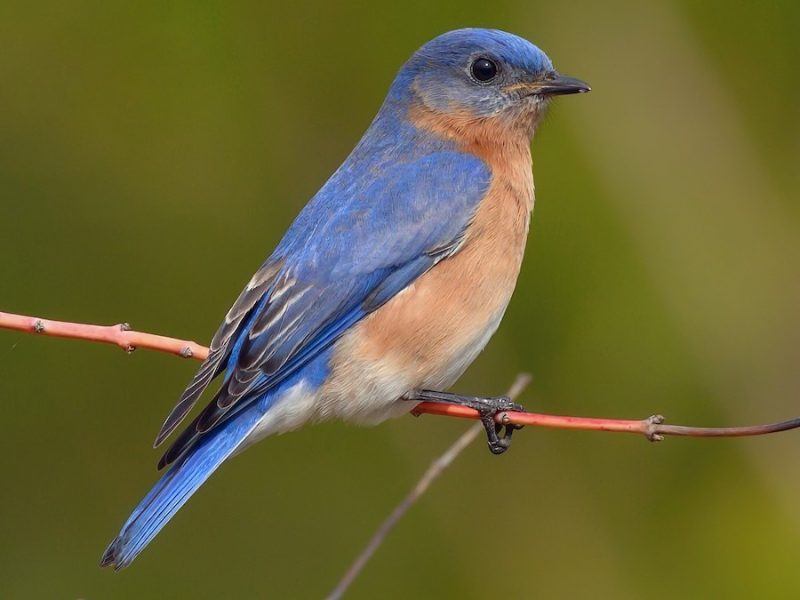
The Eastern Bluebird is a small thrush species prized for its vivid blue upperparts and warm reddish-orange chest. Males exhibit brighter and more intense blue coloring, while females are paler with grayish-blue wings and back. The bird measures about 6-7 inches in length with a wingspan of 9-12 inches.
Identification comes easily through their brilliant plumage and gentle, melodic song, which consists of soft, warbling phrases. The Eastern Bluebird’s call is a soft “cheer” or “chur-lee,” often heard in open woodlands and farmland edges across Indiana. Their gentle demeanor and bright colors make them popular with bird watchers.
Their diet mainly consists of insects and small fruits, which they hunt by perching on low branches or fence posts. Eastern Bluebirds prefer open habitats such as meadows, orchards, and parks. In Indiana, they are commonly seen nesting in tree cavities or birdhouses, especially during spring and summer months.
Red-winged Blackbird
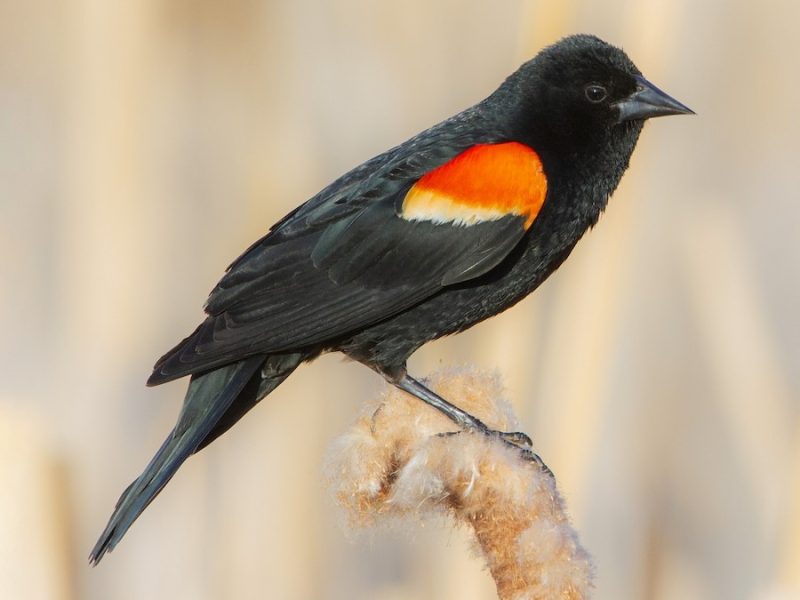
The Red-winged Blackbird is a medium-sized blackbird species well-known in Indiana for the male’s striking red and yellow shoulder patches, or epaulets. Males are glossy black overall with vivid red wing markings, while females are mottled brown and heavily streaked, making them well camouflaged. Adults range about 7-9 inches long with a wingspan near 12-16 inches.
Males are highly vocal during breeding season, emitting a distinctive “conk-la-ree!” song used to defend territory and attract mates. Females are quieter but make various calls, including harsh chatters. These birds are often found in marshes, wetlands, and grasslands, especially near bodies of water in Indiana.
Red-winged Blackbirds feed mainly on seeds and insects. They are highly social and form large flocks outside the breeding season. Their presence is very common in Indiana’s wetland habitats, where males perch conspicuously on cattails or reeds to display their bright red patches.
Mourning Dove
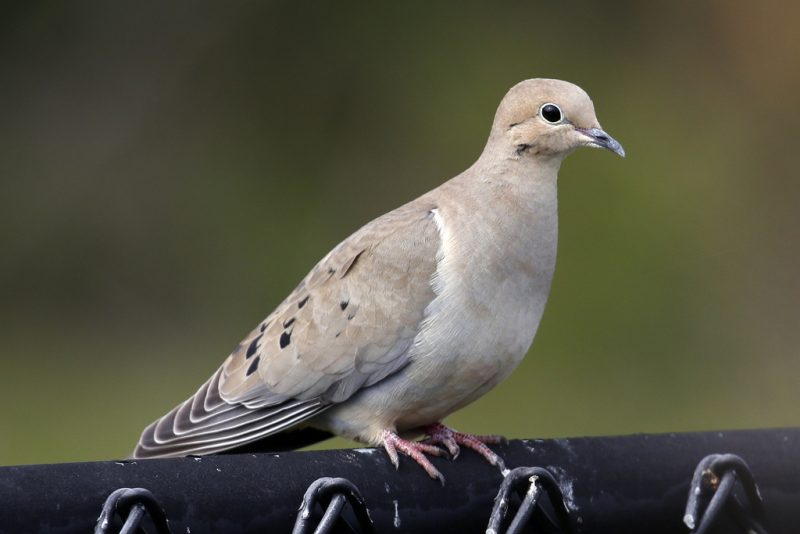
The Mourning Dove is a slender, medium-sized bird known for its soft gray-brown body, long pointed tail, and distinctive black spots on the wings. Adult doves measure around 9-13 inches in length with a wingspan of 17-18 inches. Their delicate, streamlined shape and gentle cooing make them unmistakable.
Their name derives from the mournful, drawn-out “coo-ah, coo, coo, coo” call, which is a common sound in Indiana’s fields, parks, and suburban areas. Mourning Doves often fly with swift, direct wingbeats and can be seen perching quietly on wires or tree branches.
Mourning Doves primarily eat seeds, foraging mostly on the ground. They favor open and semi-open habitats such as farmlands, grasslands, and suburban lawns throughout Indiana. Their adaptability and peaceful nature make them one of the most common and familiar wild birds in the state.
Blue Jay
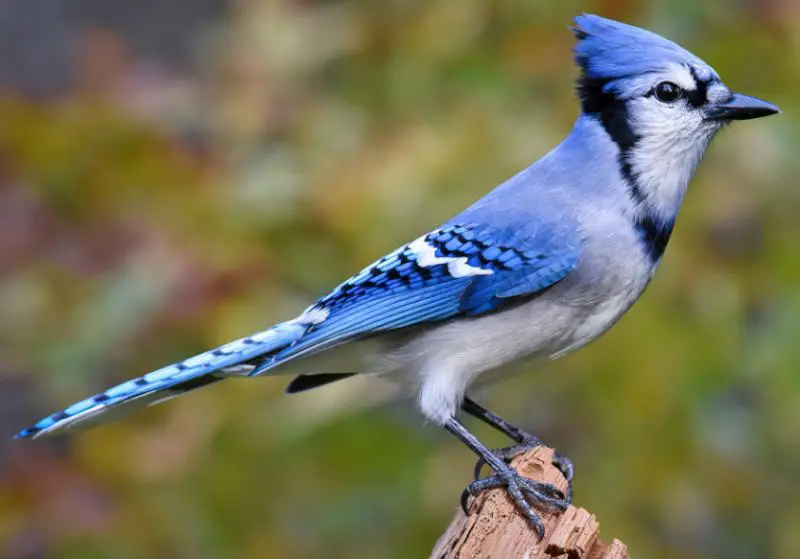
The Blue Jay is a strikingly vibrant bird recognized for its bright blue feathers, white underparts, and distinctive black markings around the neck and face. Measuring about 9-12 inches in length with a wingspan ranging from 13 to 17 inches, Blue Jays have a prominent crest on their heads and strong bills that help them forage. Their plumage appears brilliant in sunlight, making them easily noticeable in wooded areas and suburban neighborhoods.
Identification of the Blue Jay is further supported by its loud and varied calls, which range from harsh “jay-jay” sounds to mimicked calls of hawks. Their vocal repertoire allows them to communicate warnings and establish territory. Blue Jays are also known for their intelligence and curious behavior, often seen caching food for later use.
Their diet is quite diverse, including nuts, seeds, insects, and occasionally small vertebrates. Blue Jays prefer deciduous or mixed forests but have adapted well to parks and backyards throughout Indiana. They are year-round residents and play an important role in seed dispersal, especially for oak trees.
House Finch
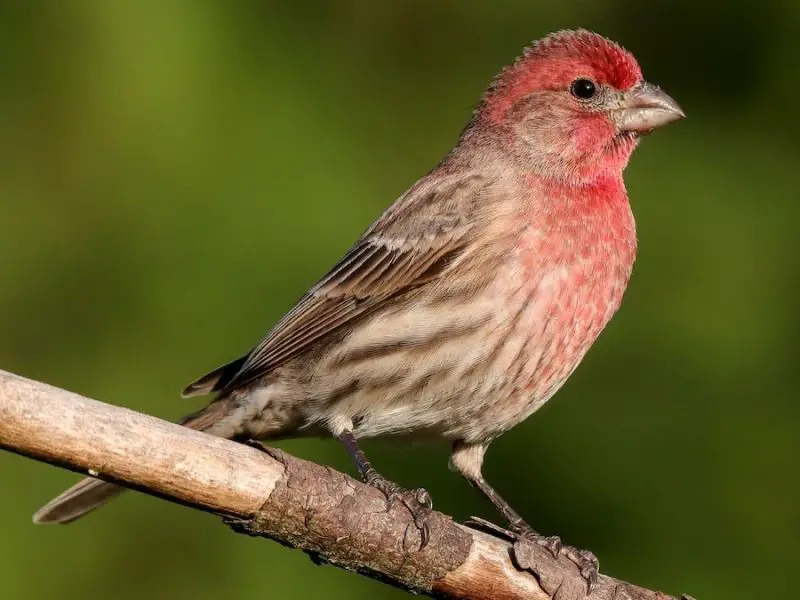
The House Finch is a small bird notable for the male’s rosy red plumage on the head, throat, and chest, while females are more subdued with brown streaks. Adults measure about 5 to 6 inches in length with a wingspan near 8 to 10 inches. Their conical bills are adapted for seed eating, and they exhibit a lively, social behavior around feeders and urban habitats.
Identification is straightforward due to the male’s red coloration and the distinctive streaked pattern on females. Their song is a cheerful warbling mix of trills and whistles that fills the air in suburban neighborhoods and parks throughout Indiana. House Finches are highly adaptable and often nest in building ledges, trees, and shrubs close to human habitation.
House Finches primarily feed on seeds, buds, and fruits, often visiting bird feeders. They thrive in urban and suburban environments, making them common and familiar birds in Indiana’s towns and cities. Their social nature makes them a delight to observe in flocks during the non-breeding season.
Downy Woodpecker
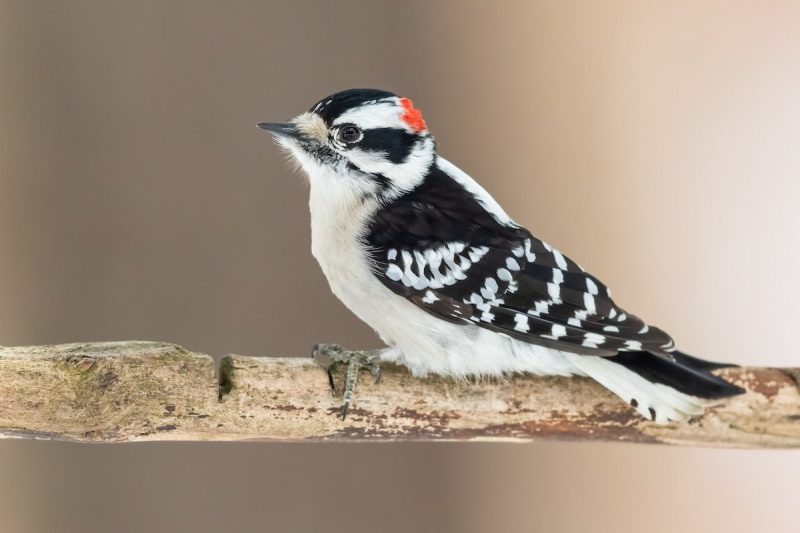
The Downy Woodpecker is the smallest woodpecker species found in Indiana, measuring about 5.5 to 6.5 inches in length with a wingspan of roughly 9 to 12 inches. It is recognized by its black-and-white plumage, white underside, and small bill compared to other woodpeckers. Males have a small red patch on the back of the head, which females lack.
Identification of this species is enhanced by its distinctive drumming sounds made on tree trunks and branches as it searches for insects. Its sharp, high-pitched call is often heard in Indiana’s forests and suburban areas. The Downy Woodpecker’s agile movements include clinging to tree bark and probing crevices with its bill.
Downy Woodpeckers mainly feed on insects like beetle larvae and ants but also consume seeds and berries. They inhabit deciduous forests, parks, and even backyard feeders with suet throughout Indiana. Their presence helps control insect populations and contributes to the ecosystem’s balance.
American Goldfinch
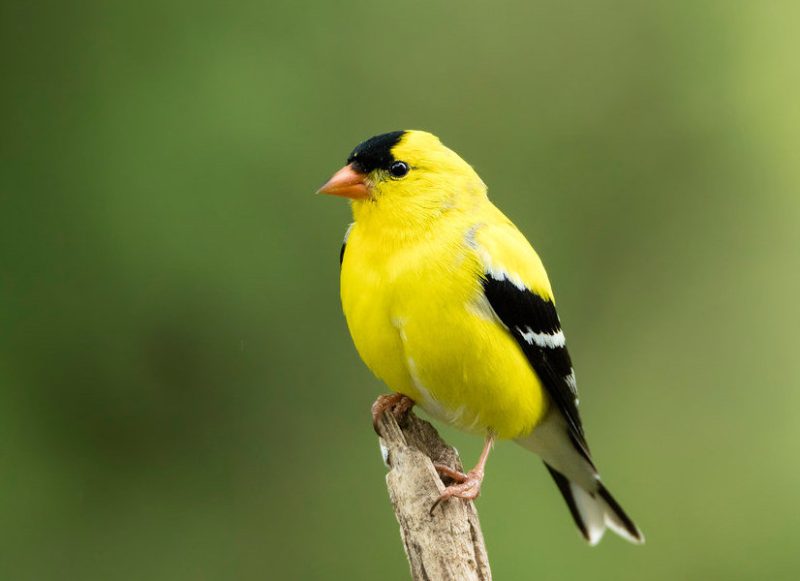
The American Goldfinch is a small, vibrant songbird best known for its bright yellow breeding plumage in males and more subdued olive-yellow coloring in females. These birds measure about 4.5 to 5.5 inches in length with a wingspan of 7.5 to 9.8 inches. They have a distinctive black forehead, wings, and tail edges that contrast beautifully with their yellow bodies during the spring and summer.
Identifying the American Goldfinch is made easier by its cheerful, twangy flight call and melodious song consisting of short, twittering phrases. These birds are often seen fluttering through fields, meadows, and backyard gardens in Indiana, especially around thistle patches and sunflower stands.
Their diet consists mainly of seeds from plants such as thistles, sunflowers, and asters. American Goldfinches prefer open areas with abundant seed-producing plants and are known for their late nesting season, often breeding well into the summer. They are common throughout Indiana and are a favorite among bird watchers.
Black-capped Chickadee
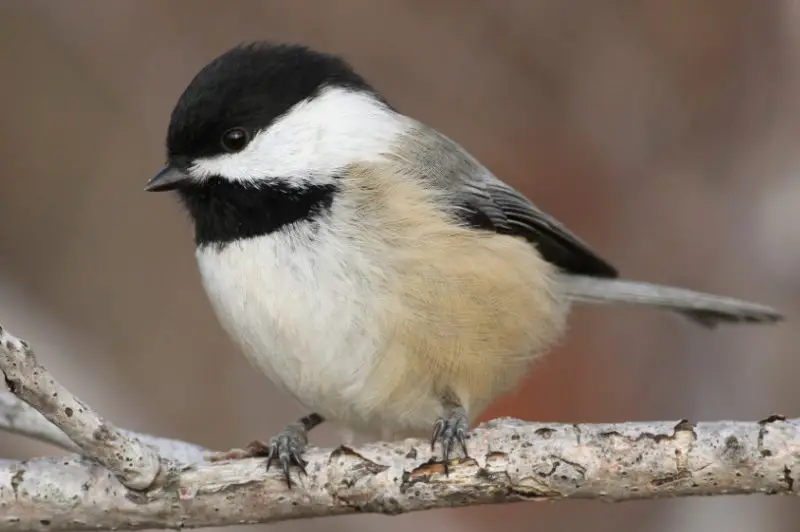
The Black-capped Chickadee is a small, lively bird measuring about 4.5 to 5.5 inches in length with a wingspan of approximately 6.3 to 8.3 inches. It is easily recognized by its distinctive black cap and bib contrasted with white cheeks and soft gray back and wings. This charming bird is a year-round resident in Indiana’s forests, woodlands, and suburban areas.
Identification includes its signature call, a clear “chick-a-dee-dee-dee” song, which varies in intensity and number of “dee” notes depending on the situation. The Black-capped Chickadee’s vocal versatility helps it communicate alarm and social interaction. It is often seen flitting energetically among tree branches or visiting backyard feeders.
This species primarily feeds on insects, seeds, and berries, often caching food to retrieve later during colder months. Its habitat preference includes deciduous and mixed forests, parks, and gardens throughout Indiana. The Black-capped Chickadee’s friendly nature and adaptability make it a favorite among bird watchers.
Tufted Titmouse
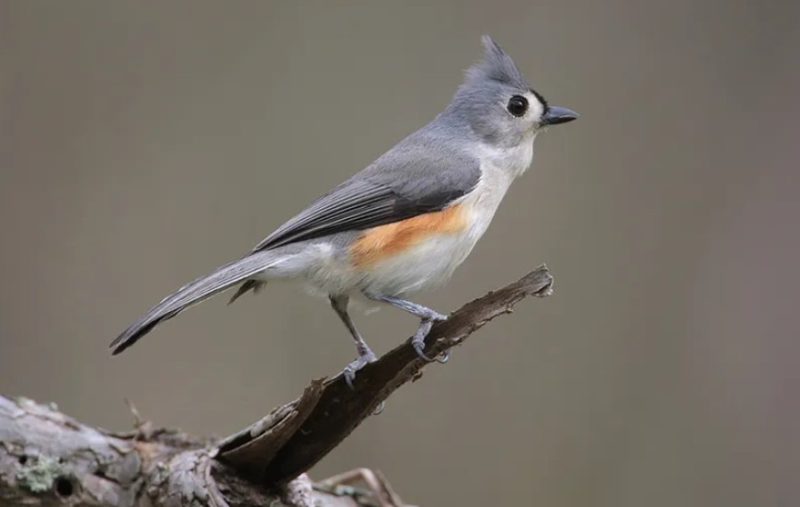
The Tufted Titmouse is a medium-small songbird about 5.5 to 6.3 inches long with a wingspan near 7.9 to 10.2 inches. It features soft gray upperparts, a white belly, and a prominent crest on its head. The bird’s black forehead and large dark eyes add to its expressive appearance, common in Indiana’s woodlands and suburban yards.
Its vocalizations include a clear, whistled “peter-peter-peter” call and a variety of trills and chips used for communication and territory defense. The Tufted Titmouse is known for its curiosity and bold behavior, often approaching bird feeders and exploring its surroundings actively.
This bird mainly feeds on insects, nuts, and seeds, frequently storing food in tree bark or crevices for later consumption. Tufted Titmice prefer deciduous forests and residential areas with mature trees throughout Indiana, where they often nest in cavities or birdhouses.
Northern Mockingbird
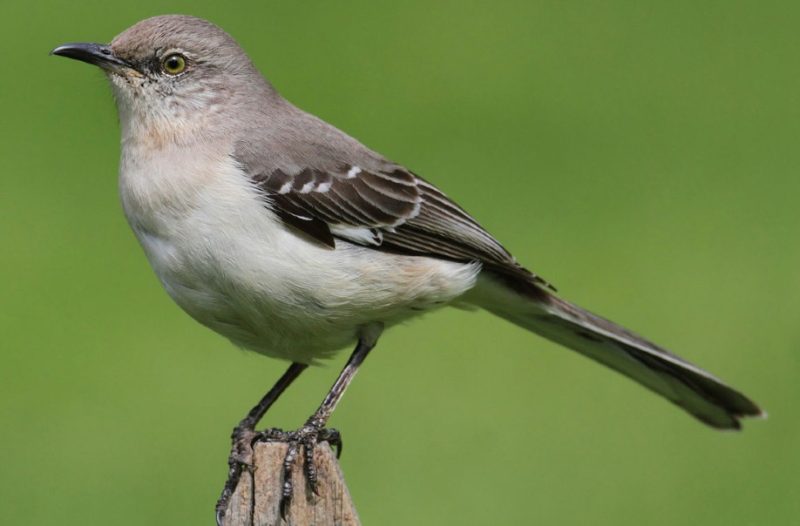
The Northern Mockingbird is a medium-sized songbird about 8 to 10 inches in length with a wingspan of 12 to 15 inches. It has gray upperparts, a white belly, and distinct white patches on the wings visible during flight. Mockingbirds are highly intelligent and known for their impressive ability to mimic the songs of other birds and sounds from their environment.
Identification is often through their varied and extended song repertoires, which can include dozens of different phrases repeated multiple times. Their calls range from melodious whistles to harsh rattles, often heard in Indiana’s open fields, suburbs, and parks. Northern Mockingbirds are territorial and use song to defend their nesting areas.
Their diet includes insects, berries, and fruits, adapting seasonally based on availability. Northern Mockingbirds prefer open habitats with scattered trees or shrubs, commonly found in Indiana’s residential neighborhoods and agricultural edges.
Carolina Wren
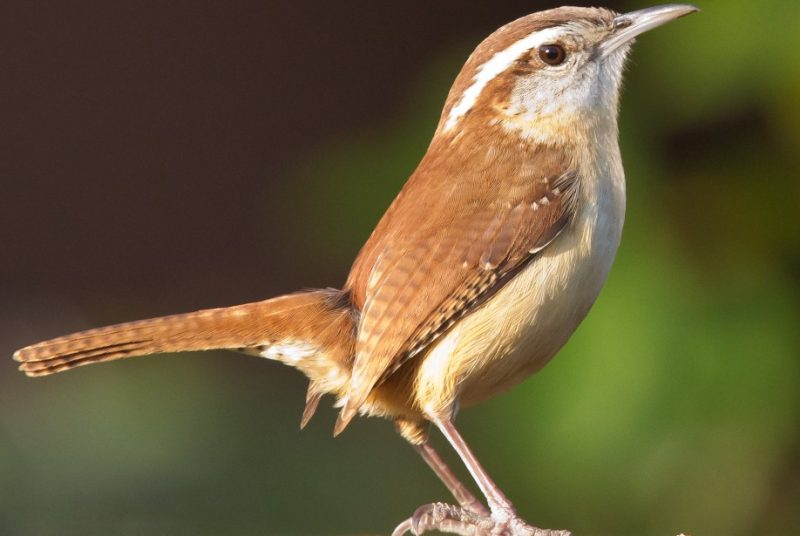
The Carolina Wren is a small, energetic bird measuring about 4 to 5 inches long with a wingspan near 6.3 to 8.3 inches. It displays a warm reddish-brown plumage with a prominent white eyebrow stripe that makes it easy to identify. This bird is known for its loud and distinctive song despite its small size, commonly heard in Indiana’s forests, gardens, and suburban areas.
Identification relies on its loud and repeated “teakettle-teakettle-teakettle” song, which carries through dense foliage and brushy areas. Carolina Wrens are often seen hopping actively on the ground or low branches, searching for insects or nesting sites. Their curious and bold nature often brings them close to human habitation.
They feed mainly on insects and spiders, supplementing with seeds and fruits during colder months. Carolina Wrens prefer dense shrubs, thickets, and wooded edges across Indiana and build nests in a variety of protected spots, including birdhouses and natural cavities.
White-breasted Nuthatch
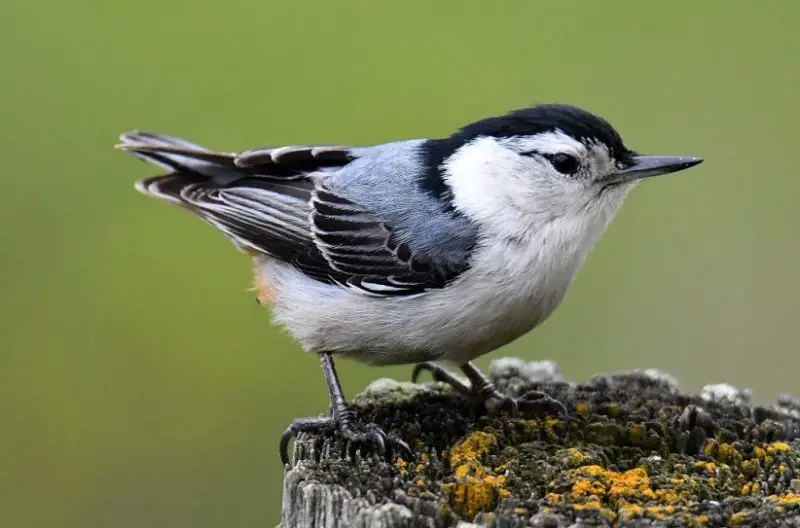
The White-breasted Nuthatch is a small bird about 5 to 6 inches long with a wingspan of roughly 9 to 11 inches. It has a striking appearance featuring a white face and underparts, blue-gray upperparts, and a black cap on the head. This species is well-known for its acrobatic behavior, often climbing down tree trunks headfirst in Indiana’s forests and suburban woodlands.
Its call is a distinctive nasal “yank-yank” sound used to communicate and establish territory. White-breasted Nuthatches have a variety of vocalizations that help them stay connected with mates or alert to predators. They are frequently observed probing bark crevices with their strong bills for insects.
The diet consists mainly of insects and seeds, and they often wedge food items into tree bark to hammer them open. White-breasted Nuthatches inhabit mature deciduous forests, woodlands, and parks throughout Indiana, showing remarkable adaptability to different forested environments.
Red-tailed Hawk
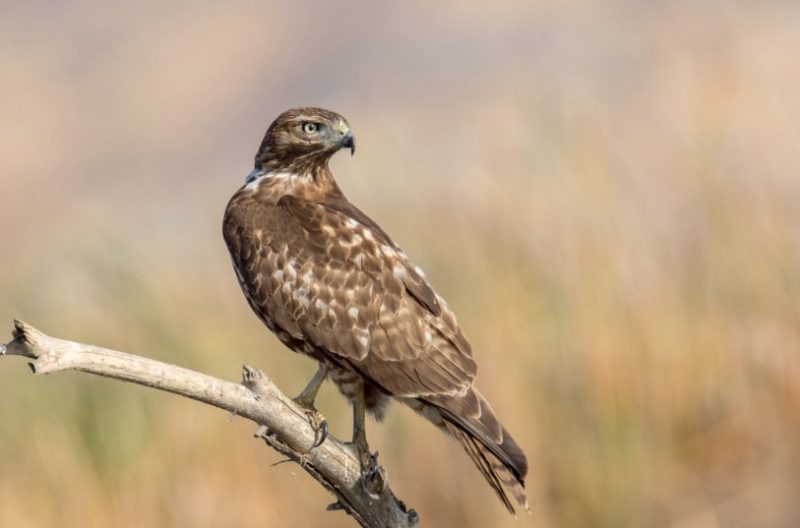
The Red-tailed Hawk is a large bird of prey, measuring about 18 to 26 inches in length with a wingspan that can reach 43 to 56 inches. It is easily identified by its rich brown upperparts and pale underparts with a distinctive reddish-brown tail, especially visible in adults. This hawk has keen eyesight and a powerful build, making it a top predator in Indiana’s skies.
Its sharp, piercing call is a characteristic high-pitched scream often used in movies to represent any hawk or eagle. The Red-tailed Hawk soars high on thermals, scanning open fields, forests, and roadsides for prey. Its flight is broad and steady with slow wingbeats and occasional soaring circles.
This bird feeds mainly on small mammals such as rodents and rabbits but will also hunt birds and reptiles. They inhabit diverse habitats across Indiana, including woodlands, farmland, and suburban areas. Their adaptability allows them to thrive near both rural and urban environments.
American Kestrel
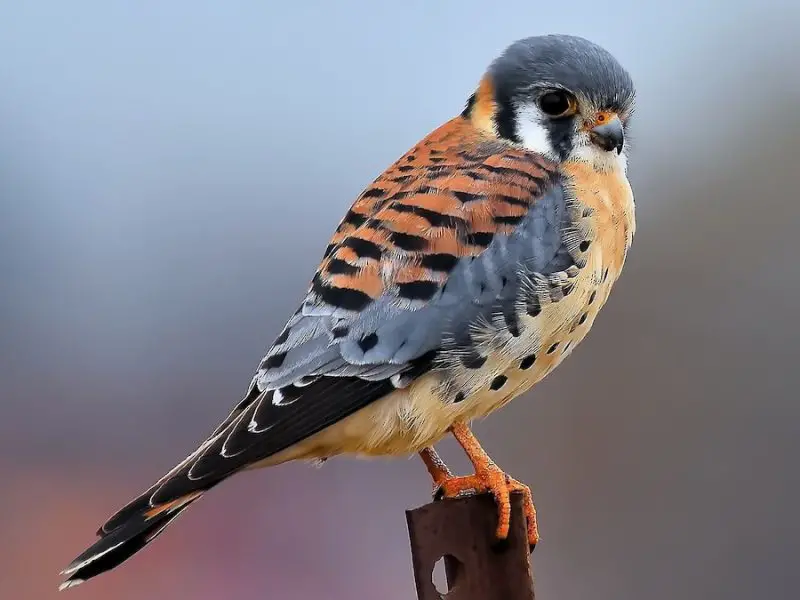
The American Kestrel is the smallest falcon in North America, measuring about 9 to 12 inches long with a wingspan around 20 to 24 inches. It has striking plumage with blue-gray wings, rusty-red back and tail, and two distinct black facial stripes. The kestrel’s nimble flight and hovering ability help it hunt efficiently.
Identification includes its sharp “klee-klee-klee” call and rapid wing beats, often seen hovering in place while hunting insects and small prey. American Kestrels perch on wires, poles, and trees in open areas across Indiana, frequently scanning the ground below.
Their diet mainly consists of insects, small birds, and rodents. They prefer open habitats such as grasslands, farmlands, and suburban edges. American Kestrels nest in cavities or birdhouses and are common year-round residents or seasonal visitors in Indiana.
Great Blue Heron
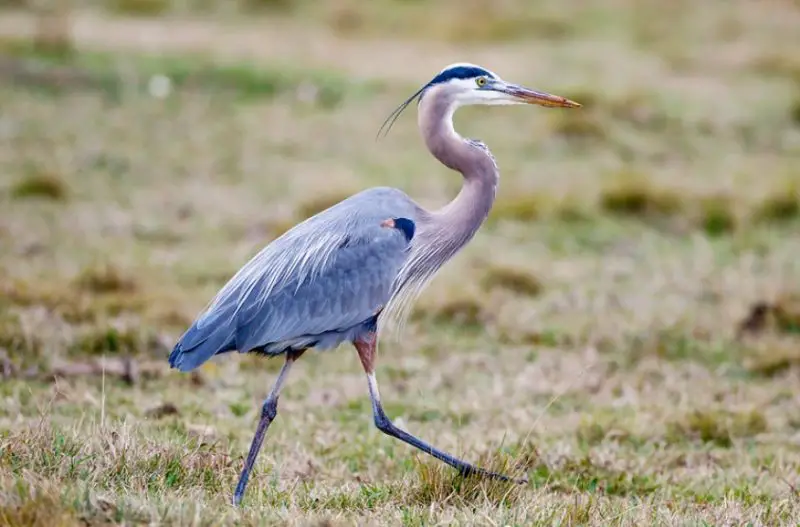
The Great Blue Heron is a tall, elegant wading bird standing about 38 to 54 inches in height with a wingspan of 66 to 79 inches. It has a slate-gray body, a long neck, and sharp yellow bill. The heron’s slow, deliberate movements and its habit of standing motionless while hunting fish make it a striking presence in Indiana’s wetlands.
Its call is a deep, harsh croak that is usually heard during flight or when disturbed. Great Blue Herons are frequently seen flying with slow wing beats and neck tucked back over their shoulders. They hunt in shallow waters, patiently stalking fish, amphibians, and small aquatic creatures.
Great Blue Herons feed primarily on fish but will also consume amphibians, insects, and small mammals. They inhabit lakes, rivers, marshes, and ponds throughout Indiana, nesting in colonies called rookeries in tall trees near water sources.
Mallard
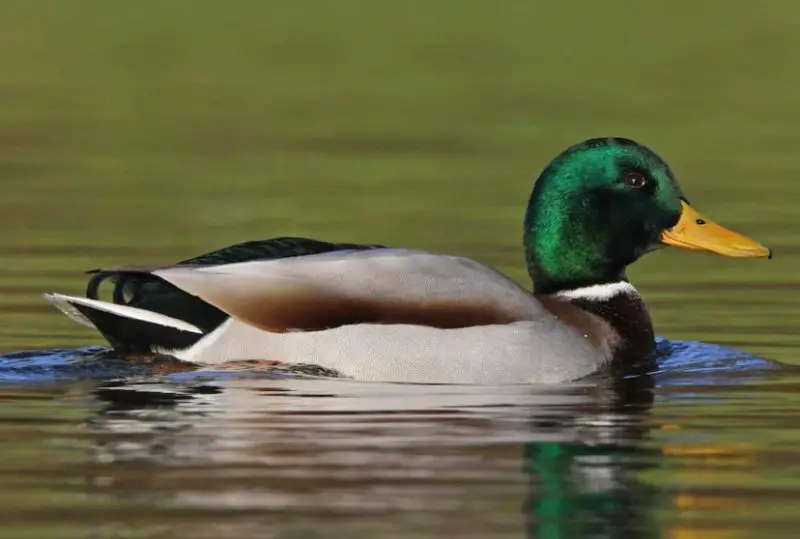
The Mallard is a common and colorful duck species found throughout Indiana. Males have a glossy green head, white neck ring, chestnut-brown chest, and gray body, while females are mottled brown with an orange bill. Mallards measure about 20 to 26 inches in length with a wingspan of 32 to 39 inches.
Identification includes their characteristic quack and the male’s striking iridescent plumage during the breeding season. Mallards are highly adaptable and found in a wide range of habitats including ponds, lakes, rivers, and urban parks across Indiana.
Their diet consists of aquatic vegetation, seeds, insects, and small fish. Mallards often dabble on the water surface or forage on land. They nest near water in dense vegetation and are among the most widespread and familiar waterfowl in the state.
Canada Goose
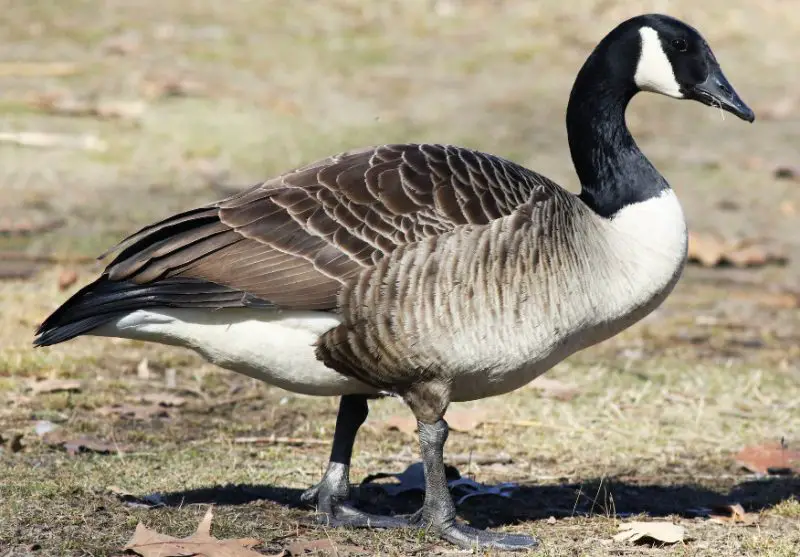
The Canada Goose is a large waterfowl species measuring about 30 to 43 inches long with a wingspan of 50 to 68 inches. It is easily identified by its black head and neck with a distinctive white cheek patch, brownish-gray body, and long neck. Canada Geese are common throughout Indiana, especially in lakes, rivers, and wetlands.
Their honking call is loud and recognizable, often heard during flight or while resting in flocks. Canada Geese migrate seasonally but many populations have become year-round residents due to abundant food and open water during winter.
They feed mainly on grasses, grains, and aquatic plants, often grazing on lawns and fields near water. Canada Geese nest on the ground near water bodies and are known for their strong family bonds and protective behavior. They are a familiar sight throughout Indiana in both rural and urban settings.
Wild Turkey
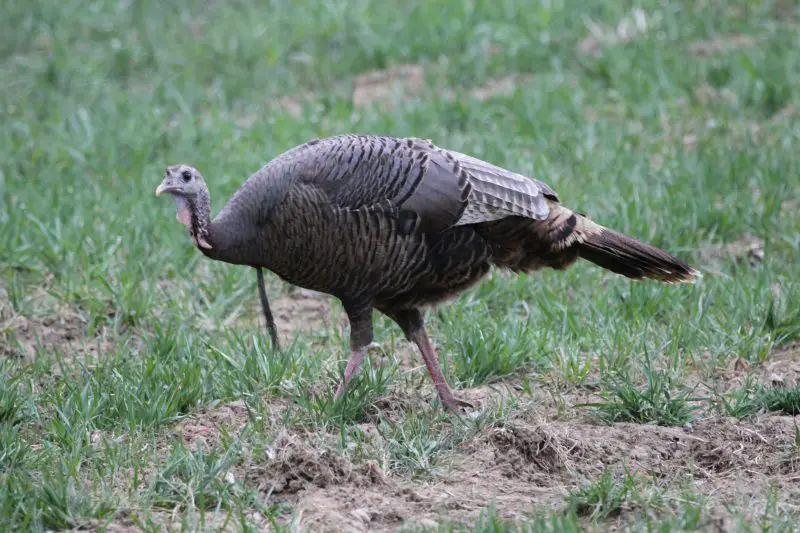
The Wild Turkey is a large, ground-dwelling bird measuring about 36 to 48 inches in length with a wingspan ranging from 4 to 5 feet. Males, known as toms, are larger with a distinctive fan-shaped tail, iridescent bronze feathers, and a bare red, blue, or white head. Females are smaller and less colorful but share the same robust body shape. Wild Turkeys are native to Indiana’s forests and open woodlands.
Identification includes their distinctive gobbling calls, especially during the breeding season, which can be heard echoing through wooded areas. They walk with a slow, deliberate gait and are known to roost in trees at night. Their large size and unique plumage make them unmistakable.
Wild Turkeys feed mainly on nuts, seeds, berries, and insects, foraging on the forest floor. They prefer mixed hardwood forests with open understory and nearby fields. Wild Turkeys are common throughout Indiana, especially in rural and suburban woodlands.
Eastern Screech-Owl
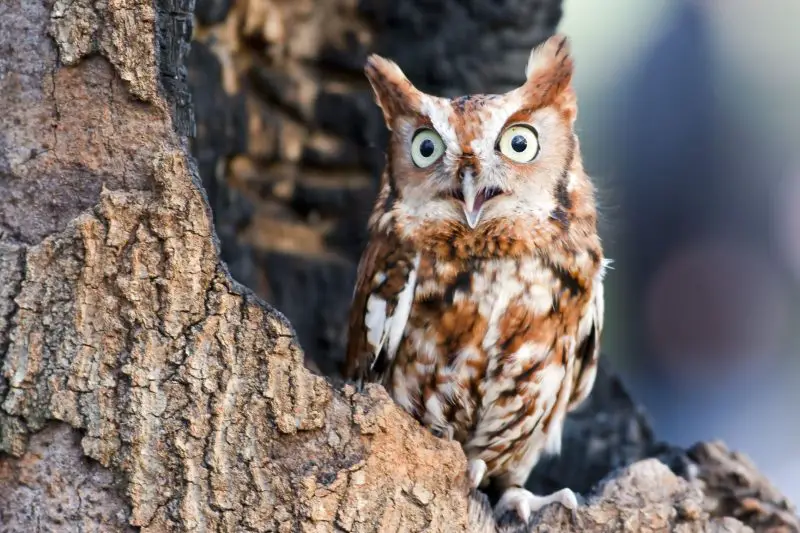
The Eastern Screech-Owl is a small, nocturnal bird about 6 to 10 inches long with a wingspan of 18 to 24 inches. It has two color morphs: gray and reddish-brown, both featuring intricate patterns that provide excellent camouflage against tree bark. This owl has large yellow eyes and prominent ear tufts, common in Indiana’s forests and wooded suburbs.
Its call is a distinctive, wavering trill or whinny sound, quite different from a typical owl hoot, often heard at dusk or night. Eastern Screech-Owls are secretive and prefer to stay hidden during the day, roosting in tree cavities or nest boxes.
These owls hunt mainly small mammals, insects, and birds, using their excellent night vision and silent flight. They inhabit wooded areas, parks, and suburban neighborhoods throughout Indiana, adapting well to human presence when suitable habitat is available.
Pileated Woodpecker
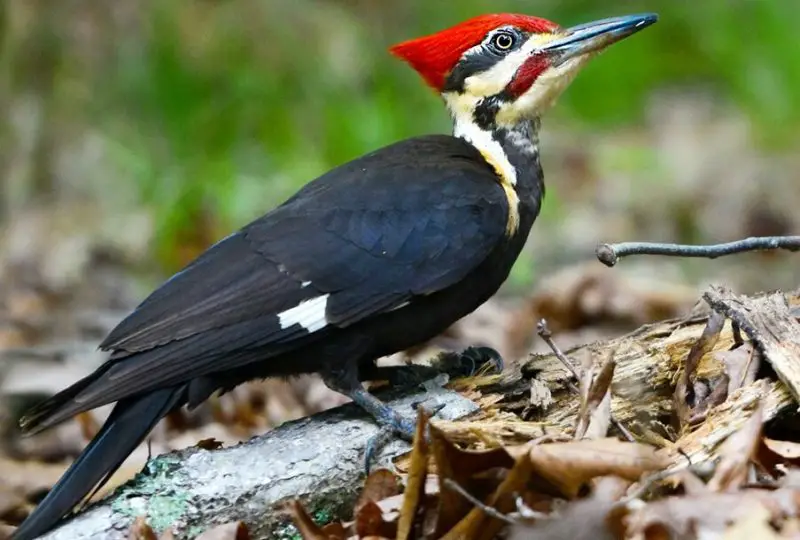
The Pileated Woodpecker is one of the largest woodpeckers in North America, measuring about 16 to 19 inches in length with a wingspan of 26 to 30 inches. It has striking black plumage with white stripes on the face and neck, and a prominent red crest. This bird’s powerful beak creates large, rectangular holes in dead trees while searching for carpenter ants and other insects.
Identification includes its loud, ringing “cuk-cuk-cuk” calls and distinctive drumming, which echoes through Indiana’s mature forests. The Pileated Woodpecker’s size and red crest make it unmistakable even at a distance.
Its diet consists primarily of ants, beetles, and other insects, but it also eats fruits and nuts. Pileated Woodpeckers prefer large tracts of mature deciduous or mixed forests with plenty of dead wood. They are resident birds in Indiana and important contributors to forest ecology.
Eastern Towhee
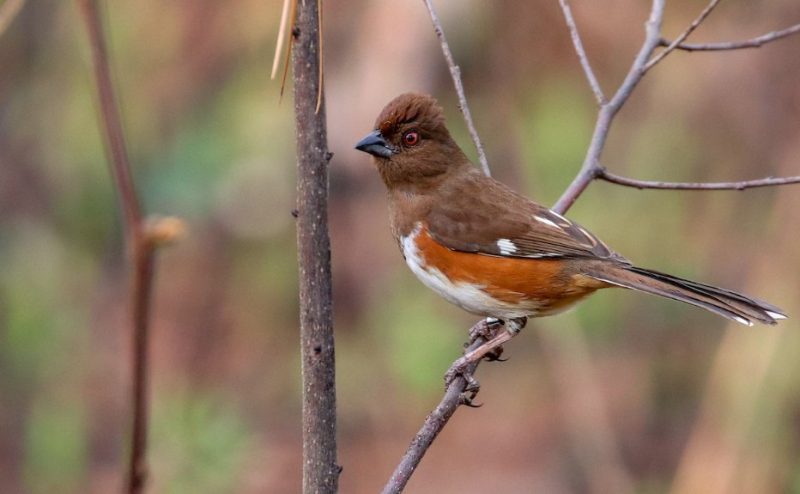
The Eastern Towhee is a medium-sized sparrow about 7 to 8 inches long with a wingspan of approximately 11 to 13 inches. Males display striking black upperparts, bright rufous sides, and white underparts, while females are similar but with brown replacing black. This bird is commonly found in shrubby areas and forest edges throughout Indiana.
Identification is aided by its distinctive song, a clear “drink-your-tea” or “tow-hee” call often heard during spring and summer. Eastern Towhees forage on the ground by scratching through leaf litter with both feet to uncover seeds and insects.
Their diet includes seeds, fruits, and insects. They prefer dense understory vegetation in woodlands, hedgerows, and brushy fields. Eastern Towhees are widely distributed across Indiana and are a favorite sight for birdwatchers during the breeding season.
Chipping Sparrow
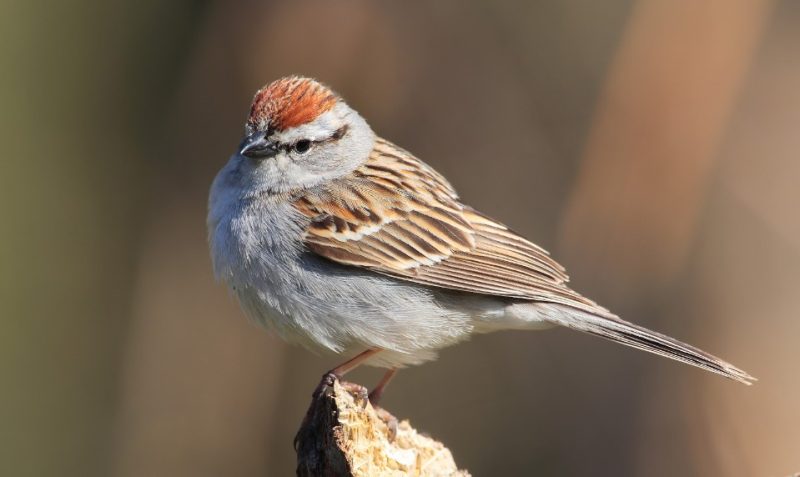
The Chipping Sparrow is a small, slender songbird about 5 inches long with a wingspan of roughly 7.5 to 8.7 inches. It has a rusty crown, black eye line, and grayish underparts. These sparrows are common migrants and summer residents in Indiana, often seen in open woodlands, parks, and suburban yards.
Identification includes their bright, mechanical trill song lasting several seconds, usually heard in the spring and early summer. Chipping Sparrows forage mostly on the ground for seeds and insects and can often be seen perched on low branches.
Their diet consists mainly of seeds and small insects. They favor open habitats with scattered trees and shrubs, nesting in low bushes or small trees. Chipping Sparrows are widespread in Indiana during the breeding season and admired for their cheerful song.
FAQ about Wild Birds in Indiana
What are some common wild birds found in Indiana?
Indiana is home to a variety of wild birds including Northern Cardinal, American Robin, Eastern Bluebird, Red-winged Blackbird, Mourning Dove, Blue Jay, and many others. These species are commonly seen in forests, parks, suburban areas, and wetlands throughout the state.
When is the best time to observe wild birds in Indiana?
The best time for birdwatching in Indiana is during the spring and fall migration seasons when many species pass through the area. Early mornings in these seasons offer the best chances to see and hear diverse bird species. Summer and winter also provide opportunities to observe resident birds.
What habitats support wild birds in Indiana?
Wild birds in Indiana inhabit diverse environments including deciduous forests, wetlands, grasslands, suburban neighborhoods, and farmlands. Different species prefer specific habitats, such as woodpeckers in mature forests and waterfowl near lakes and rivers.
How can I attract wild birds to my backyard in Indiana?
To attract wild birds, provide a variety of native plants, bird feeders with seeds like sunflower or millet, fresh water sources, and shelter such as shrubs or birdhouses. Planting native trees and shrubs can also offer natural food and nesting sites.
Are there any endangered or protected wild birds in Indiana?
Yes, Indiana is home to several protected bird species under state and federal laws, including the Bald Eagle and some migratory songbirds. It is important to respect wildlife regulations and avoid disturbing nesting sites.
What should I do if I find an injured wild bird in Indiana?
If you find an injured wild bird, contact a licensed wildlife rehabilitator or local animal control agency. Avoid handling the bird excessively and keep it in a quiet, safe container until professional help arrives.
Can I feed wild birds year-round in Indiana?
Feeding wild birds year-round is possible and beneficial, especially during harsh winters when natural food sources are scarce. However, it’s important to keep feeders clean and provide appropriate food to prevent disease.
How do wild birds in Indiana adapt to urban environments?
Many wild birds have adapted well to urban and suburban settings by utilizing parks, gardens, and bird feeders for food and shelter. Species like House Finches and American Robins thrive in these areas due to their flexibility in diet and nesting habits.

